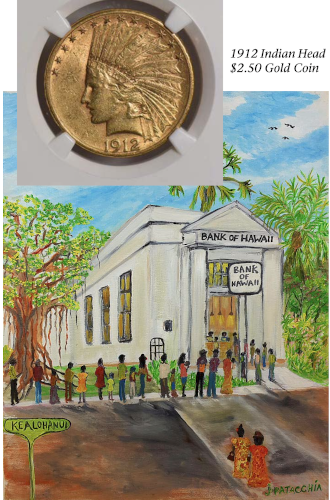By Boyd Ready
Anyone visiting Waialua town would naturally ask – what is that building with the columns across from the library? This neo-classical structure, with prominent Ionic columns and high entry arch, was a sort of ‘temple of commerce.’ Built in 1917, it was Bank of Hawaii’s second branch on Oahu. The builder was Henry Freitas, and the cost was expect- ed to be eleven thousand dollars. World War I had started, and Waialua Agriculture Co. was 19 years old.
How different banking was 107 years ago! Mon- ey handled at Bank of Hawaii would be in both gold coin and four kinds of US paper currency: silver certificates, gold certificates, United States Notes, or ‘greenbacks,’ and the new Federal Reserve Notes. Hawaiian coins issued under Kalakaua had gone out of circulation. Waialua’s thousands of laborers were paid in gold coin or currency, including the ‘Indian head’ $2.50 gold piece, the ‘Eagle’ $10.00 with an Indian head reverse, and the ‘Double Eagle’ $20.00 coins. Paper currency could be changed for gold.
Bank of Hawaii even started with a pile-of-gold publicity stunt. Young Castle & Cooke associates had been denied a loan from Bishop & Co. (now First Hawaiian Bank), and had bounced a check. When they were flush again, they took all their money, in gold coin, out of Bishop and Co. and wheelbar- rowed it down Bishop Street to start their own bank. As most were in their 20s, the new bank’s first nick- name was the ‘Kindergarten Bank.’
One enterprising manager, Andrew Anderson, Sr., who had recently helped start the Waipahu branch near Oahu Sugar and Ewa Plantations, hustled to get Waialua customers. He and his wife visited Waialua’s many remote camps on a regular route, with a strongbox in their car, to collect de- posits and provide withdrawals, curb-service, you might say. This practice acquainted workers with the uses of a bank, and proved the need for a new branch. The laborers, working 60-hour weeks, and living in small wood cottages, needed a safe place for their gold coin and currency.
Andersen served as Waialua’s branch manager for 29-years, until 1946. He and assistant manager, Robert Koike, sometimes appeared in the news with a vacation announcement, or when they were ap- pointed marriage license agents. Most spectacular .
was the 1928 capture of a kidnapper who murdered a 10-year-old child. Bank of Hawaii officials had shrewdly published the serial numbers of the ran- som cash. From a train ticket bought in Waialua, a $5 bill on the list, and his lunch at Sea View Inn, the former Waialua student was recognized. Waial- ua Civic Club members, along with Anderson and Koike, got the school yearbook, found his home ad- dress, and police captured him. The volunteers do- nated the large reward to local causes.
The artist for the bank’s line-of-customers paint- ing, Julie Patacchia, remembers how hot it was to stand in the long line at the bank on paydays, and, after the Bank got air conditioning, what a relief it was to finally get inside.
The bank moved to the Waialua Shopping Cen- ter in 1970. The old classic building became the ‘Sugar Bar,’ with German sausages and beer, popular with locals and motorcycle clubs. Later it became the Woolley Brothers screen printing shop until 2019 when it became vacant due to the roof failing.
For more information about the Historical Soci- ety go to www.WaialuaHistoricalSociety.org or contact Antya Miller at 808-342-8557 to schedule a Hale‘iwa or Waialua historical walking tour.



